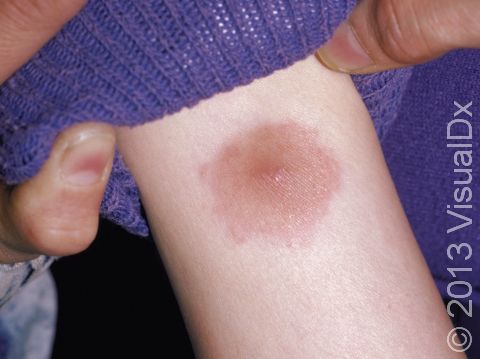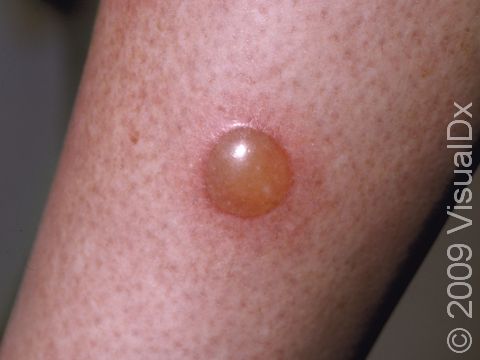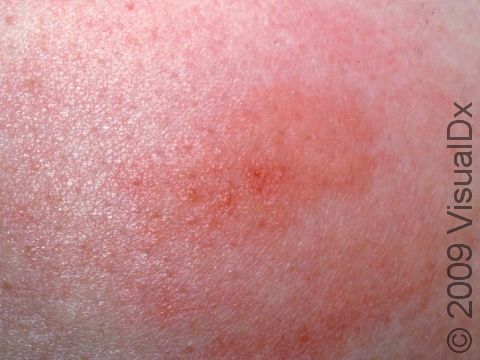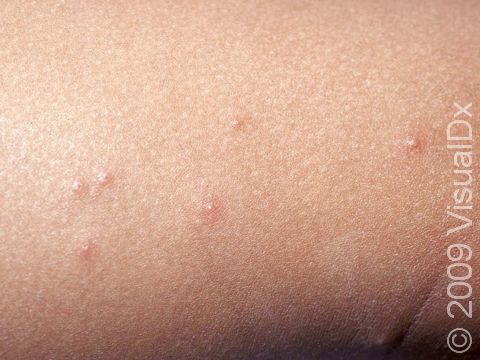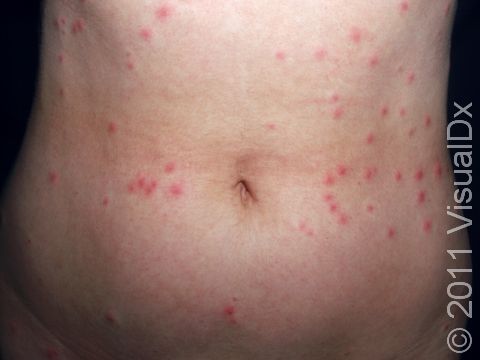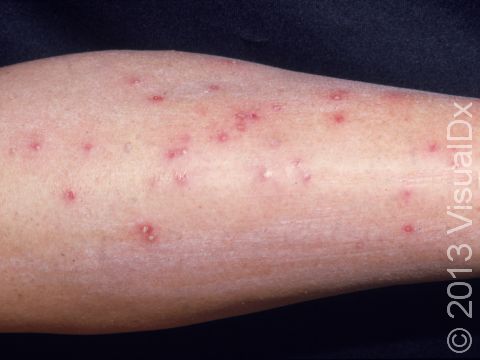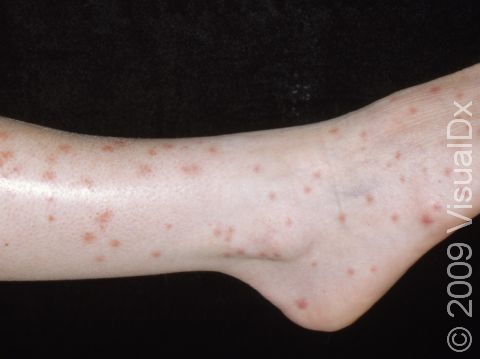Bug Bite or Sting
Bites or stings from insects (arthropods) are very common. Most reactions are mild and result from an allergic reaction to either the insect or the toxins injected with the bite or sting. Some people have severe reactions to the stings of:
- Bees.
- Wasps.
- Hornets.
- Yellow jackets.
These stings may require emergency help. The bites of most insects, such as ants, mosquitoes, flies, spiders, ticks, and mites, do not cause such a severe reaction.
It may be hard to tell which type of insect has caused the skin lesions, as many insect reactions are similar. Flying insects tend to bite or sting exposed skin areas, while bugs such as fleas tend to bite the lower legs and around the waist, and they often have several bites grouped together. Some individuals are far more sensitive to insect bites and have more severe reactions, so the fact that no one else in the family has lesions does not rule out an insect bite.
Who's At Risk?
Insect bites and stings are a problem in all regions of the world. In the Midwest and East Coast regions of the United States, mosquitoes, flying insects, and ticks account for most bites. In drier areas of the Western US, crawling insects are more of a problem.
There is no proven effect of age, race / ethnicity, or sex in terms of bite reactions.
Severe allergic reactions to stings occur in 0.5%-5% of the US population.
Signs & Symptoms
Insect bites usually present as small, itchy, red papules (small, solid bumps). Occasionally, vesicles (small fluid-filled blisters) may occur at the site of bites or stings. In some situations and in some locations, such as the lower leg or shin, bullae (fluid-filled blisters larger than a thumbnail) can occur. Some insects, such as fire ants, are known to cause a painful and itchy pustule (small pus-filled bump).
In lighter skin colors, the bites and stings may be faint pink or red. In darker skin colors, the redness may be harder to see. Using a bright light may help show any subtle color changes.
Flying insects tend to choose exposed areas not covered by clothing, while some bugs (such as fleas) focus on the lower legs. Bedbugs prefer the arms, legs, chest, and face, often biting several times in the same area and leaving a group of lesions.
Common reactions to arthropod stings include:
- Redness, pain, and swelling.
- Severe reactions such as facial swelling, difficulty breathing, and shock (anaphylaxis).
- Fever, hives, and painful joints (although these reactions are not as common).
Very few spiders cause severe reactions. The black widow spider may cause only a mild local reaction at the bite site, but pain, stiffness, chills, fever, nausea, and abdominal pain may follow within a few hours. Similarly, the brown recluse spider may cause a marked skin reaction after a few hours, with redness, pain, blistering, and ulcers forming, as well as fever, nausea, and fatigue.
Self-Care Guidelines
For stings:
- Bees may leave a stinger behind; if so, try to gently scrape off the stinger with a blunt object, such as a credit card.
- Wash the wound with soap and water.
- Apply an ice pack or cold water for a few minutes.
- Take acetaminophen (eg, Tylenol) for pain and an antihistamine (eg, loratadine [Claritin] or diphenhydramine [Benadryl]) for itching, as needed.
For insect bites:
- Wash with soap and water.
- Apply cool compresses.
- Use antihistamines to relieve itching and take acetaminophen for pain.
- Using 1% hydrocortisone cream may help reduce the itching.
For ticks (still attached):
- Using tweezers, grasp the tick as near the skin as possible and pull firmly until it releases.
- Swab the area with alcohol or soap and water.
- Save the tick for identification, if needed.
- Wash the area with soap and water, then apply 1% hydrocortisone cream in anticipation of any reaction.
Treatments
Depending on the type of insect bite or sting and its reaction, your medical professional might treat you in the following manner.
For insect bites:
- Prescription topical corticosteroids
- Muscle relaxants, pain medicines, antivenom, antibiotics, and sometimes local surgery to relieve venomous insect bites
For stings:
- Antihistamines or corticosteroids
- Epinephrine, antihistamines, corticosteroids, intravenous fluids, and oxygen (for anaphylaxis)
- Injectable epinephrine or nasal epinephrine spray for those with known severe allergic reactions
- Immunotherapy to reduce the chance of repeated severe reactions
Visit Urgency
Some arthropod bites / stings are more dangerous than others. If a black widow or brown recluse spider bite is suspected, apply ice to the area and seek medical help. Symptoms of these bites include:
- A deep blue or purple area around the bite, often with a surrounding white area and a red outer ring.
- Abdominal pain.
- Headache.
- Fever.
- Fatigue.
- Nausea.
- Muscle stiffness.
If an attached tick is seen and you live in a region where Lyme disease is prevalent, call your medical professional for a single dose of doxycycline that will be helpful in preventing Lyme disease. If it is more than 72 hours since tick removal, doxycycline will not be effective. If the site of the tick bite develops a red, swollen, spreading area, seek medical help to check for Lyme disease. Similarly, seek medical attention for any general Lyme disease symptoms, such as fatigue, fever, joint pain, among others, that develop within the month following a tick bite.
For stings, call 911 if you develop:
- Generalized hives, itching, or swelling in areas beyond the sting site.
- Swelling of the lips or throat.
- Tightness in the chest or difficulty breathing.
- Hoarse voice or tongue swelling.
- Dizziness or loss of consciousness.
Trusted Links
References
Bolognia J, Schaffer JV, Cerroni L. Dermatology. 4th ed. Philadelphia, PA: Elsevier; 2018.
James WD, Elston D, Treat JR, Rosenbach MA. Andrew’s Diseases of the Skin. 13th ed. Philadelphia, PA: Elsevier; 2019.
Kang S, Amagai M, Bruckner AL, et al. Fitzpatrick’s Dermatology. 9th ed. New York, NY: McGraw-Hill Education; 2019.
Last modified on August 12th, 2024 at 12:11 pm

Not sure what to look for?
Try our new Rash and Skin Condition Finder
